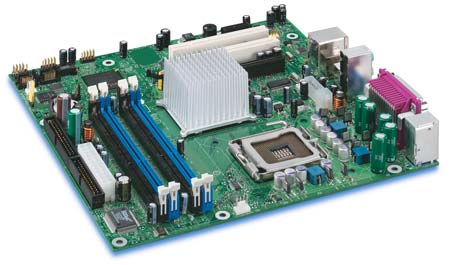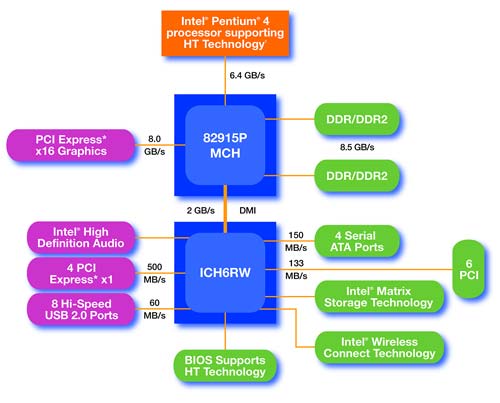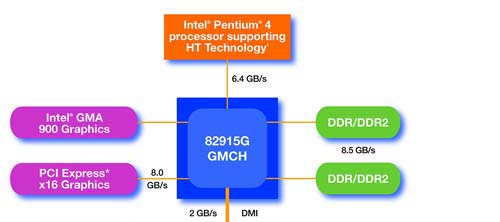Intel 925X/915: Chipset Performance & DDR2
by Wesley Fink on June 19, 2004 3:01 AM EST- Posted in
- CPUs
Intel 915G Express
Intel also provided a D915GUX motherboard for evaluation.
The 915 chipset comes in several flavors, both with and without the new Intel integrated graphics.

Most mainstream boards geared to AnandTech readers will feature the 915p chipset, without integrated graphics. The chipset is essentially a 925X without the acceleration technology, but with the added option of using either DDR or DDR2 memory, depending on what memory support the manufacturer chooses to provide. Other options are provided by the Southbridge and depend on which ICH6 version is paired with the 915P.

915G offers the same options as 915P, but adds Intel's integrated graphics. Intel has significantly upgraded integrated graphics for the 915 chipset, and now support DirectX 9 and OpenGL 1.4 on their integrated graphics. The new solution is called "Intel Graphics Media Accelerator 900". Intel claims that performance is doubled over Intel Intense Graphics 2. AnandTech takes a closer look at the performance of the new Intel integrated Graphics in the review of the Socket 775 CPU launch and PCIe Graphics that is the companion to this article. There is also an economy version of the 915 called 915GV, with integrated Media Accelerator 900 graphics, but without a PCIe 16X graphics card slot. We suspect that the 915GV will become a favorite of the Corporate desktop.

The D915GUX that we evaluated had all of the 915 features in a micro ATX form factor. Despite the smaller size, the D915GUX still provides integrated graphics, plus a PCIe 16X graphics slot, a PCIe 1X slot, and 2 PCI slots. All of the Intel boards, even the 915gux, provide 4 DIMM slots and support up to 4GB of memory. Please also notice that a 24-pin power connector, and not a 20-pin, is also a feature of 915 boards. 20-pin is backwards compatible, however, and the 24-pin is keyed to accept a standard 20-pin connector on one side of the new 24-pin.










57 Comments
View All Comments
nserra - Tuesday, June 22, 2004 - link
You guys are only evaluating the performance, I think it's not that important, the features yes, those are important. The P4 is crap even with hyper-x,y,z, so it wasn't a "chipset" that was going to make a miracle.I would like to see the new platform tested, IGP, Sound system, EMT64 (is it enable on LGA775 processors?), NX bit?, new power saving techniques, so new features up to test.
At least the DDR vs DDR2 comparison is a good thing.
I was hopping that DD2 would give a performance boast, since the P4 architecture relies on higher bandwidth and higher latency (the pros of RDRAM i850), but I guess not....
Bozo Galora - Monday, June 21, 2004 - link
yes he's sureRyanVM - Monday, June 21, 2004 - link
#54, Are you sure you aren't thinking of the S754/S939 dual socket mobo?tfranzese - Sunday, June 20, 2004 - link
#53, yes, there's a board that was shown at Computex that had both sockets giving the option to use one or the other.RyanVM - Sunday, June 20, 2004 - link
So, any chance that the 915 chipset can be tied to a socket 478 + Northwood? :DMarlin1975 - Sunday, June 20, 2004 - link
AMD does not really need dual ch. memory. Look at the diff. between a socket 939 and 754, it is very little for most apps. Also Dual Ch memory is not new. It was used WAY back in the day.The only reason it is back is because intel can't design a decent CPU so they have to make up for it with pricey and unneeded tech.
tfranzese - Sunday, June 20, 2004 - link
Anemone, there's really little reason you need dual-channel memory on the AMD64 platform with the memory controller being on the chip.Anemone - Sunday, June 20, 2004 - link
Anti overclocking designs in the new chipsets? Very poor choice.I will reiterate Intel performance per $ over its previous generations is pathetic. More $ required per degree of performance and the increase over last year is poor.
AMD is expensive until you get to the 754 - but perhaps I'm mistaken but I thought the industry had left single channel memory configurations behind 2 years ago. Oh wait, it's AMD, that's about their catchup period, sorry. So yes look at AMD in dual channel AMD64 chips and yes they are very pricey. So much for their argument that by providing competition they keep prices down.
Add to all that the overclocking unfriendly stuff, and while AMD comes out as better overall, the performance per $ is still not markedly better than last year, imo.
:)
Bozo Galora - Sunday, June 20, 2004 - link
"My My We are in trouble now arent we..."Yeah, I guess we might have to offer AMD a few of our (cash in the bank) billions to buy them out. I wonder if the FTC will allow that? Hmmmmm. Let's investigate.
firtol88 - Saturday, June 19, 2004 - link
My My we are in trouble now aren't we...Looks like AMD is the clear choice, unless you need a heater.